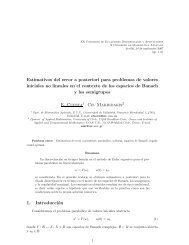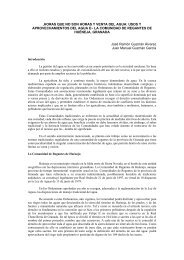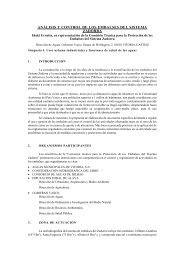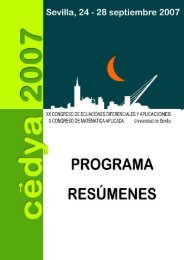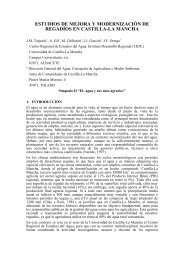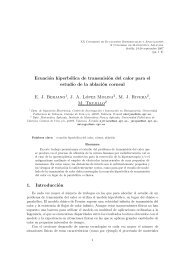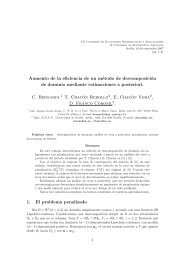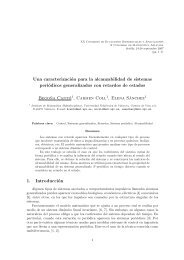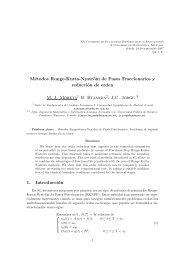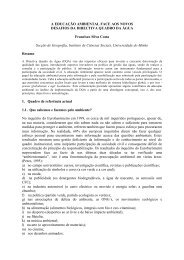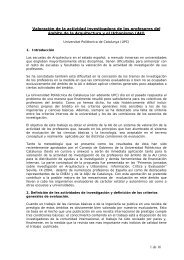LIBRO DE ACTAS (pdf) - Universidad de Sevilla
LIBRO DE ACTAS (pdf) - Universidad de Sevilla
LIBRO DE ACTAS (pdf) - Universidad de Sevilla
Create successful ePaper yourself
Turn your PDF publications into a flip-book with our unique Google optimized e-Paper software.
Retentional Syntagmatic Network, and its Use in Motivic Analysis of Maqam Improvisation<br />
the traditional representation, would belong to separate segments. This would hence represent<br />
the interconnections between segment anchors, but also more subtle interconnections as well.<br />
The syntagmatic weight between two notes can in a first step be based on the actual distance<br />
between these two notes along the various musical dimensions. Assigning such weight to<br />
successive notes of monodies would enable to reconstruct the rules stated in segmentation<br />
mo<strong>de</strong>ls such as in the GTTM (Lerdahl & Jackendoff, 1983) and in the LBDM<br />
(Cambouropoulos, 2006). The next step in this study would be to generalize this analysis, beyond<br />
the syntagmatic surface, to RSNs. Syntagmatic weights would be assigned to all existing<br />
syntagmatic connections; monodic segmentation could be performed based on a summation of<br />
the weights, and polyphonic multi-layer segmentation could be studied as well.<br />
5. Current and future works<br />
The specification of the RSN, of their use in motivic pattern analysis and connectivity analysis<br />
is currently un<strong>de</strong>r study. Other ongoing research questions are mentioned in this section.<br />
5.1 Integration to The MiningSuite<br />
The MiningSuite is a new platform for the analysis of music, audio and signal currently<br />
<strong>de</strong>veloped by Lartillot (2011) in the Matlab environment. One module of The MiningSuite, called<br />
MusiMinr, enables to load and represent in Matlab symbolic representations of music such as<br />
scores. It also integrates an implementation of the algorithm that automatically constructs the<br />
syntagmatic network out of the musical representation. Mo<strong>de</strong>s can also be specified, in or<strong>de</strong>r to<br />
enable the modal analysis and the specification of the RSN. Motivic analysis can also be<br />
performed automatically.<br />
We plan to enable the graphical representation of the analytical results in a form that would<br />
i<strong>de</strong>ally resemble what can be seen on Figure 1. Alternatively, the result of the analysis can be<br />
used to output hypothetical segmentation points, represented in a <strong>de</strong>dicated representation in<br />
MusiMinr. Actual listeners segmentation can be imported as well and compared to the theoretical<br />
results.<br />
MusiMinr also integrates a module that attempts transcription of audio recordings of pieces of<br />
music into score representations. Actually, the whole musical analysis is progressively performed,<br />
including the syntagmatic, modal and motivic analyses, in the same time as the transcription<br />
itself. In this way, higher-level musical knowledge, such as the expectation of a given modal<br />
<strong>de</strong>gree or a motivic continuation, is used to gui<strong>de</strong> the transcription itself (Lartillot, 2012).<br />
5.2 Feedback of pattern discoveries in the syntagmatic network<br />
Motivic patterns that are discovered in the syntagmatic network might reinforce the<br />
syntagmatic weight of the paths actualized by the pattern occurrences. They might also induce<br />
possible perturbations in the syntagmatic network: syntagmatic connections that were<br />
theoretically possible can be altered if the new pattern occurrences interfere through masking.<br />
The pattern analysis is performed on the syntagmatic network during the progressive<br />
construction of the syntagmatic network itself: each new syntagmatic connection ad<strong>de</strong>d at the<br />
end of the network induces a search for associated patterns. In this way, when a pattern is<br />
progressively <strong>de</strong>tected,<br />
the possible continuations of that pattern, as indicated by the children in the pattern tree,<br />
can be used as gui<strong>de</strong> to draw the new syntagmatic connections with the new notes;<br />
the new pattern occurrences may interfere in the establishment of distant connections<br />
from notes before those occurrences to the new notes currently heard.<br />
216



